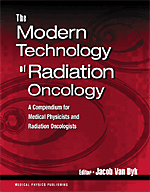
The Modern Technology of Radiation Oncology, Vol 1
Author: Jacob Van DykISBN: 9780944838389 ISBN10: 0944838383
Published: 1999 | 1072 pp | Hardcover
Price: $ 175.95
Table of Contents
Table of Contents
Radiation Oncology Overview Jacob Van Dyk
Clinical Implementation of Technology and Quality Assurance Process Jacob
Van Dyk and James Purdy
Patient Immobilization Lynn Verhey and Gunilla Bentel
Simulators Jacob Van Dyk and Peter Munro
CT Simulators Jacob Van Dyk and John Taylor
Simulators Computed Tomography A.T. Redpath and T.M. Kehoe
Imaging for Radiation Therapy Planning (MRI, Nuclear Medicine, Ultrasound)
Terry Peters, Piotr Slomka and Aaron Fenster
Computerized Radiation Treatment Planning Systems Jacob Van Dyk, Robin
Barnett, and Jerry Battista
Kilovoltage X-Rays Peter Biggs, Charlie Ma, Karen Doppke, Azam Niroomand-Rad,
and John Beatty
Cobalt-60 Teletherapy Glenn Glasgow
Medical Accelerators Ervin Podgorsak, Peter Metcalfe, and Jacob Van
Dyk
Beam Shaping and Intensity Modulation Arthur Boyer, Lei Xing, and Ping
Xia
Megavoltage Radiography for Treatment Verification Peter Munro
Radiation Oncology Information Management System Kenneth Brooks
Tomotherapy G.H. Olivera, D.M. Shepard, K. Ruchala, J.S. Aldridge, J.
Kapatoes, E.E. Fitchard, P.J. Reckwerdt, G. Fang, J. Balog, J. Zachman, T.R.
Mackie
Stereotactic Irradiation Ervin Podgorsak and Matthew Podgorsak
Total Body Irradiation with Photon Beams, Ervin Podgorsak and Matthew
Podgorsak
Total Skin Electron Irradiation, Ervin Podgorsak and Matthew
Podgorsak
Intraoperative Radiation Therapy, Ervin Podgorsak and Matthew
Podgrosak
Brachytherapy Glenn Glasgow
Dose Measuring Tools, Tomas Kron
Proton Therapy Michael Moyers
Neutron Therapy, Richard Maughan and Mark Yudelev
Hyperthermia: Local Hyperthermia Bhudatt Paliwal, Prakash Shrivastava,
Eduardo Moros, and Richard Steeves
Hyperthermia: Whole Body Hyperthermia H. Ian Robins and Dörthe
Katschinski
Photodynamic Therapy Michael Patterson and Brian Wilson
Boron Neutron Capture Therapy Robert Zamenhof, Paul Busse, Otto Harling,
and John Goorley
Monoclonal Antibody and Other Internal Emitter Therapies Lawrence Williams,
An Liu, and Grace Wong
Preface
Radiation Oncology is a very technology intensive discipline of medicine. Complex, sophisticated equipment is required to localize the tumor, to generate ionizing radiation, and to deliver a high radiation dose to a three-dimensional target volume while sparing normal tissues. A number of books have been written about the medical physics and clinical aspects of radiation oncology and treatment planning. The standard medical physics textbooks tend to discuss the basic concepts of radiation interactions and dosimetry, and some of the technical aspects as related to treatment machines and treatment planning. However, they generally do not address the design details of many of the practical tools that are required to prepare patients for treatment or that are used as part of the treatment process. Virtually no textbook addresses the details of acceptance, commissioning, and quality assurance of radiation therapy equipment.
The purpose of this book is to describe the details of the technology associated with radiation oncology. A special emphasis is placed on the design of all the equipment allied with radiation treatment. In addition, this book describes the procedures that are required to implement this equipment into clinical service (needs assessment, purchase, acceptance, and commissioning) and, once it is in use, the quality assurance that is required to keep the equipment operational at acceptable levels. In addition to describing all the tools that are used in "standard" radiation treatment centers, this book addresses the less common or evolving technologies and, thus, provides a comprehensive overview. Anyone embarking on any of these new procedures will be able to gain some basic insight as to what is required to make that procedure clinically viable.
Nowhere can all these technologies be found in one cancer therapy center. However, the staff of every cancer center is involved in improving procedures by either purchasing new equipment or by upgrading existing equipment. This book is intended to be a guide for those embarking on these procedures. While the body of each chapter is written at a level understandable by medical physcists and radiation oncologists, additional detailed information for medical physicists is provided in the appendices at the end of some of the chapters.
As the title indicates, the book is primarily intended for medical physicists and radiation oncologists although it will also benefit radiation therapists (radiographers) and dosimetrists, and to a lesser extent other allied professionals such as engineering technologists, radiobiologists, and administrators. It is intended to be both a reference text for those who have been working in the field for some years as well as an educational tool for those who are entering the field. It is assumed that the reader has a basic knowledge of medical physics as found in other standard medical physics textbooks.
Jacob Van Dyk


